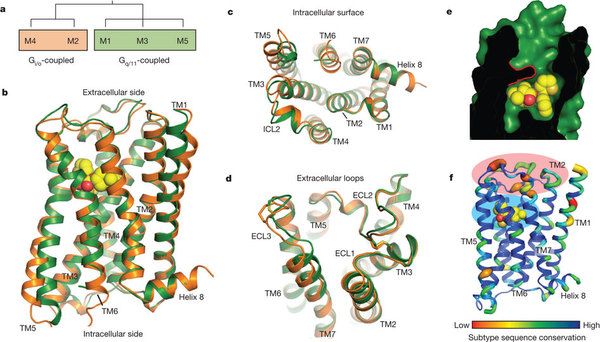Muscarinic receptors are a part of the parasympathetic system.
They are stimulated by the neurotransmitter acetylcholine, released at the nerve endings.
Hence along with the nicotinic receptors, they are called cholinergic receptors.
All the muscarinic receptors are G-protein coupled receptor types.
Unlike nicotinic receptors, showing a response in milliseconds, these muscarinic receptors respond in a few seconds to minutes.
Muscarinic Receptors types
There are five types of muscarinic receptors, which can be divided based on their response mechanism and specific function.
The list of muscarinic receptors include
- M1 receptor
- M2 receptor
- M3 receptor
- M4 receptor
- M5 receptor

Of the five types, M1, M2, and M3 are present in a significant proportion, while the other two are limited to nerve endings in the brain.
Further, the M1, M3, and M5 receptors work by activating the inositol phosphate pathway.
While the M2 and M4 receptors inhibit adenylyl cyclase from reducing intracellular cyclic Adenosine Monophosphate (cAMP).
M1 Receptor
These receptors are located mainly in the central nervous system (CNS) in the regions like the cortex, hippocampus, striatum of the brain, and ganglionic cells.
The receptor is also called Gq muscarinic receptor as it is a Gq protein-coupled receptor.
They are also located in the peripheral neurons and the stomach parietal cells.
Functions of the M1 receptor
These receptors have excitatory effects on the CNS. They are primarily involved with the control of motor functions, learning, and memory,
In the stomach, they regulate gastric secretion under the influence of the vagus nerve.
These receptors mediate the release of histamine, which stimulates histamine (H2) receptors in the stomach to secrete hydrochloric acid.
M1 agonist and antagonist
Oxytremorine acts as an agonist for the M1 receptor, while pirenzepine and telenzepine act as anatomists.
M2 Receptors
M2 receptors are majorly present in the heart and few visceral smooth muscles. They are also found in presynaptic terminals of central and peripheral neurons.
The function of M2 receptors
They have an inhibitory effect on the heart.
On the heart, stimulation of M2 receptors leads to a decrease in heart rate (bradycardia) and a reduction in the force of contraction of the heart.
This occurs due to the inhibition of calcium channels.
They also have an inhibitory effect on the presynaptic neurons of central and peripheral neurons.
Their actions are also responsible for analgesia and tremor in Parkinsonism.
M2 receptor agonist and antagonist
These are selectively stimulated by pilocarpine and antagonized by gallamine and methoctramine.
M3 Receptors
These receptors are primarily found in smooth muscles of the eye, blood vessels, intestines, and glands.
The glands include salivary glands, sweat glands, and those in the respiratory tract.
Function
They control the constriction of the iris in the eye.
In the lungs, they are involved in bronchoconstriction and facilitate the expiration of air.
They also dilate blood vessels by releasing nitric oxide, an endothelial relaxation factor.
On the glands, they enhance the secretion of the respective gland.
M3 receptor agonist and antagonist
These are selectively stimulated by bethanechol and antagonized by solifenacin and darifenacin.
M4 Receptors
These are located only in the brain and are mainly distributed in the forebrain and striatum.
Function
They are thought to play a vital role in learning and drug abuse.
M4 receptor agonist and antagonist
Oxotremorine, an agonist for all the above receptors, is also a non-selective agonist for the M4 receptor.
However, the selective antagonist is Ipratropium and Mamba toxin (a snake venom)
M5 Receptors
These are confined to the brain regions like the substantial nigra, striatum, hippocampus, midbrain pons medulla, cortex, and cerebellum of CNS, and also the iris of the eye.
Functions
This receptor is thought to play an essential role in dopaminergic transmission in the brain. It also regulates salivary gland secretion and also pupillary constriction.
Agonists and antagonists
Acetylcholine and carbochol act as non-selective agonists. While atropine, oxybutynin act as a non-selective antagonist.
All the muscarinic receptors are G-protein coupled receptors.
But, have minor differences among the mechanism of G-protein function, as mentioned above, for individual receptor types.